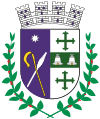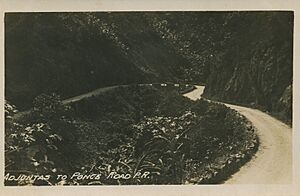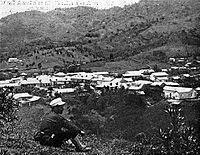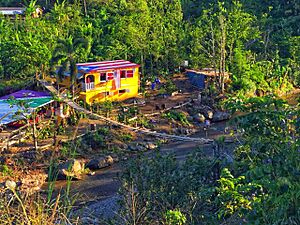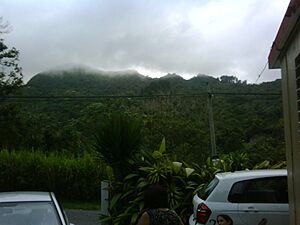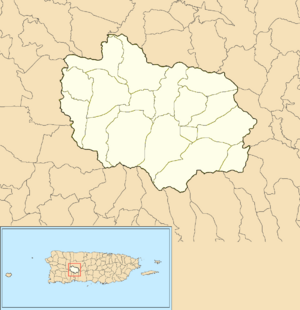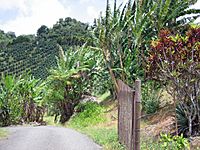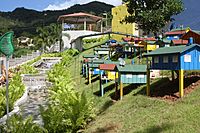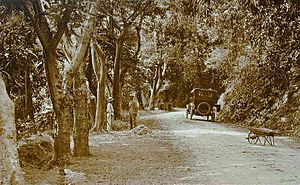Adjuntas, Puerto Rico facts for kids
Quick facts for kids
Adjuntas
Municipio Autónomo de Adjuntas
|
|||
|---|---|---|---|
|
Town and Municipality
|
|||

View of Adjuntas Pueblo and El Gigante Dormido from a nearby mountain.
|
|||
|
|||
| Nicknames: | |||
| Anthem: Adjuntas es mi amor | |||

Map of Puerto Rico highlighting Adjuntas Municipality
|
|||
| Sovereign state | |||
| Commonwealth | |||
| Settled | 1739 | ||
| Founded | August 11, 1815 | ||
| Founded by | Diego Maldonado | ||
| Barrios | |||
| Area | |||
| • Total | 67.10 sq mi (173.8 km2) | ||
| • Land | 66.69 sq mi (172.7 km2) | ||
| • Water | .41 sq mi (1.1 km2) | ||
| Elevation | 2,316 ft (706 m) | ||
| Population
(2020)
|
|||
| • Total | 18,020 | ||
| • Rank | 62nd in Puerto Rico | ||
| • Density | 268.55/sq mi (103.69/km2) | ||
| Demonym(s) | Adjunteños | ||
| Time zone | UTC−4 (AST) | ||
| ZIP Codes |
00601, 00631
|
||
| Area code(s) | 787/939 | ||
| Major routes | |||
Adjuntas is a small mountain town and municipality in Puerto Rico. It is located in the central-western part of the island. Adjuntas is known for its cool weather. This is why it is often called "the Switzerland of Puerto Rico."
The town's average yearly temperature is about 70°F (21°C). The lowest temperature ever recorded in Puerto Rico was in Adjuntas, at 38°F in 2018. This mild climate makes Adjuntas a popular spot for tourists, especially during summer. You can find a small hotel called Monte Rio and a country inn, Villa Sotomayor, there.
Adjuntas is divided into 16 barrios (neighborhoods) and the downtown area, known as Adjuntas Pueblo. The town is about a two-hour drive west from the capital, San Juan. Its ZIP Code, 00601, is the lowest standard ZIP code in the United States ZIP code system.
Contents
What Does the Name Adjuntas Mean?
The name Adjuntas means "attached" or "in proximity" in Spanish. It likely comes from the phrase "lands attached to Coamo." This is because the area was originally part of the lands of Villa de San Blas de Illescas, an older settlement in Puerto Rico. Adjuntas became its own municipality in 1739.
The town has several fun nicknames:
- La Ciudad del Gigante Dormido ("City of the Sleeping Giant"): This refers to a mountain that looks like a sleeping man.
- La Suiza de Puerto Rico ("Puerto Rico's Switzerland"): This nickname comes from its cool temperatures and mountainous landscape.
- La Tierra de los Lagos ("Land of the Lakes"): This name is given because of the many natural pools formed by rivers flowing through the area.
A Look Back: The History of Adjuntas
Even though there are ancient rock carvings (called petroglyphs) from the Taíno people in Adjuntas, we don't have proof that a specific Taíno chief ruled the area.
During the Spanish colonization in the 16th century, a Spanish interpreter named Juan González might have settled here. There's also a legend about Spanish explorers looking for gold in the Adjuntas region.
Adjuntas was first part of the San Blas de Illescas (Coamo village). As more people moved to Ponce, Adjuntas became more connected to that town. Later, it became a part of Utuado in 1739.
On August 11, 1815, Adjuntas was officially founded as its own town. This happened after 20 families living there asked for it to be recognized. Diego Maldonado was chosen as its first representative. Soon after, a city hall and a public square were built.
Many immigrants from the Mediterranean islands of Corsica and Majorca came to Adjuntas after the mid-19th century. Some of them started coffee plantations. By the late 1800s, coffee from Adjuntas was sent to Europe, the United States, and even the Vatican.
In 1894, the Spanish Government declared Adjuntas a "villa," meaning a first-order municipality. A few years later, in 1898, the United States Army occupied the town during the Spanish–American War. President Theodore Roosevelt even visited Adjuntas in 1906.
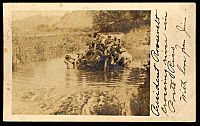
In the 1960s, valuable deposits of copper, gold, and other minerals were found. This led to a conflict, as local community and environmental groups opposed mining. Casa Pueblo, a local organization in Adjuntas, fought against the mining to protect Puerto Rico's natural resources.
In 1992, a US company called Southern Gold Resources was allowed to look for gold in Adjuntas and Utuado.
On September 20, 2017, Hurricane Maria hit Adjuntas hard. The hurricane caused many landslides and damaged the town's power system. This left over 18,000 residents without electricity. A part of PR-10, a main road, collapsed. The mayor reported that 1,500 homes were completely destroyed. Adjuntas was also affected by the 2020 earthquakes, which caused more landslides and power outages.
The Legend of the Sleeping Giant
El Gigante Dormido ("the sleeping giant") is a mountain in Adjuntas. It looks like a man lying on his back, with his face profile visible in the mountain ridges. A local legend tells the story of this giant.
Many years ago, a giant lived in the region. People wanted to live in the fertile lands, but the giant would stretch his arms and peek his head over the mountains. A witch learned that to defeat the giant, she had to hit his right eye with a poisoned arrow. One day, she did.
The giant cried out in pain and fell flat on his back. As he fell, he punched the ground hard, creating a spot where water began to bubble up. Over time, the giant turned to stone in that position. This is how the mountain that looks like a sleeping giant came to be.
Exploring the Geography of Adjuntas
Adjuntas is very mountainous because it is located in the Cordillera Central mountain range. It shares borders with Utuado to the north and east, Lares and Yauco to the west, and Guayanilla, Peñuelas, and Ponce to the south.
An old historian, Pedro Tomás de Córdova, described the land as "high, mountainous, and very healthy." He also noted that the land was excellent for farming. The highest point in Adjuntas is Monte Guilarte, which is about 3,773 feet (1,150 meters) tall. It is the sixth highest peak in Puerto Rico and is part of Guilarte State Forest.
Adjuntas has many rivers and creeks. Some of the rivers that flow through the area include Río Cidra, Río Corcho, Rio de la Ciénaga, Río Garzas, Río Guilarte, Río Limaní, Río Saltillo, Río Toro, Río Vacas, and Río Yahuecas. Since Adjuntas is in the mountains, it does not have any beaches.
Neighborhoods of Adjuntas
The municipality of Adjuntas is divided into 17 main areas called barrios. One of these is the downtown area, known as the barrio-pueblo.
These barrios are further divided into smaller areas called sectores (sectors). These can be called urbanización, reparto, barriada, or residencial, among others.
Climate of Adjuntas
| Weather chart for Adjuntas (Climate – Tropical Rainforest (Af)) | |||||||||||||||||||||||||||||||||||||||||||||||
|---|---|---|---|---|---|---|---|---|---|---|---|---|---|---|---|---|---|---|---|---|---|---|---|---|---|---|---|---|---|---|---|---|---|---|---|---|---|---|---|---|---|---|---|---|---|---|---|
| J | F | M | A | M | J | J | A | S | O | N | D | ||||||||||||||||||||||||||||||||||||
|
2.5
80
54
|
2.5
80
53
|
3.8
81
54
|
7.2
82
57
|
9.5
83
60
|
5
85
61
|
6
85
61
|
8.4
85
61
|
13
85
61
|
11
84
60
|
6.7
82
59
|
3.2
80
56
|
||||||||||||||||||||||||||||||||||||
| temperatures in °F precipitation totals in inches |
|||||||||||||||||||||||||||||||||||||||||||||||
|
Metric conversion
|
|||||||||||||||||||||||||||||||||||||||||||||||
Adjuntas has a tropical rainforest climate, but because it's high up in the mountains, it feels much cooler.
- Summers: Days are warm (83°-85°F / 28°-29°C), and nights are mild (60°-63°F / 16°-17°C).
- Winters: Days are moderately warm (around 79°F / 26°C in town, or 68°F / 20°C in the mountains). Nights are cool (55°-60°F / 13°-16°C), and can drop to 45°F (7°C) after cold fronts.
| Climate data for Adjuntas, Puerto Rico (1991–2020 normals, extremes 1970–present) | |||||||||||||
|---|---|---|---|---|---|---|---|---|---|---|---|---|---|
| Month | Jan | Feb | Mar | Apr | May | Jun | Jul | Aug | Sep | Oct | Nov | Dec | Year |
| Record high °F (°C) | 89 (32) |
92 (33) |
90 (32) |
93 (34) |
93 (34) |
92 (33) |
92 (33) |
92 (33) |
91 (33) |
91 (33) |
93 (34) |
88 (31) |
93 (34) |
| Mean daily maximum °F (°C) | 79.3 (26.3) |
79.8 (26.6) |
80.2 (26.8) |
81.4 (27.4) |
82.6 (28.1) |
84.6 (29.2) |
84.9 (29.4) |
85.1 (29.5) |
84.8 (29.3) |
84.0 (28.9) |
82.0 (27.8) |
79.9 (26.6) |
82.4 (28.0) |
| Daily mean °F (°C) | 67.9 (19.9) |
67.7 (19.8) |
68.5 (20.3) |
70.3 (21.3) |
72.3 (22.4) |
74.0 (23.3) |
74.1 (23.4) |
74.4 (23.6) |
74.0 (23.3) |
73.3 (22.9) |
71.6 (22.0) |
69.1 (20.6) |
71.4 (21.9) |
| Mean daily minimum °F (°C) | 56.6 (13.7) |
55.6 (13.1) |
58.7 (14.8) |
59.2 (15.1) |
62.0 (16.7) |
63.3 (17.4) |
63.2 (17.3) |
63.6 (17.6) |
63.3 (17.4) |
62.6 (17.0) |
61.2 (16.2) |
58.3 (14.6) |
60.5 (15.8) |
| Record low °F (°C) | 41 (5) |
43 (6) |
40 (4) |
46 (8) |
47 (8) |
50 (10) |
51 (11) |
52 (11) |
46 (8) |
48 (9) |
42 (6) |
40 (4) |
40 (4) |
| Average precipitation inches (mm) | 2.62 (67) |
2.58 (66) |
4.44 (113) |
7.23 (184) |
9.88 (251) |
4.57 (116) |
5.74 (146) |
9.08 (231) |
12.94 (329) |
10.85 (276) |
6.68 (170) |
3.59 (91) |
80.20 (2,037) |
| Average precipitation days (≥ 0.01 in) | 13.8 | 12.1 | 12.9 | 15.8 | 17.3 | 12.4 | 15.4 | 17.6 | 20.1 | 19.6 | 18.5 | 15.7 | 191.2 |
| Source: NOAA | |||||||||||||
People and Economy of Adjuntas
| Historical population | |||
|---|---|---|---|
| Census | Pop. | %± | |
| 1900 | 19,484 | — | |
| 1910 | 16,954 | −13.0% | |
| 1920 | 17,988 | 6.1% | |
| 1930 | 18,075 | 0.5% | |
| 1940 | 22,556 | 24.8% | |
| 1950 | 22,424 | −0.6% | |
| 1960 | 19,658 | −12.3% | |
| 1970 | 18,691 | −4.9% | |
| 1980 | 18,786 | 0.5% | |
| 1990 | 19,451 | 3.5% | |
| 2000 | 19,143 | −1.6% | |
| 2010 | 19,483 | 1.8% | |
| 2020 | 18,020 | −7.5% | |
| U.S. Decennial Census 1899 (shown as 1900) 1910–1930 1930–1950 1960–2000 2010 2020 |
|||
| Racial – (self-defined) Adjuntas, Puerto Rico – 2010 Census |
||
|---|---|---|
| Race | Population | % of Total |
| White | 18,146 | 93.1% |
| Black/African American | 603 | 3.1% |
| American Indian and Alaska Native |
68 | 0.4% |
| Asian | 5 | 0.0% |
| Native Hawaiian Pacific Islander |
1 | 0.0% |
| Some other race | 411 | 2.1% |
| Two or more races | 249 | 1.3% |
In 2020, Adjuntas had a population of 18,020 people.
Farming and Industry
Since it was founded, Adjuntas' economy has relied on farming. They grew coffee, sugarcane, small fruits, and raised cattle. In the mid-20th century, sugar production decreased as factories came to the island.
Today, Adjuntas is still the main producer of coffee in Puerto Rico. Other crops grown here include bananas, citron, and peaches. After Hurricane Maria in 2017, many women in Adjuntas started working in agriculture, helping the economy grow again.
In the mid-20th century, some factories opened in Adjuntas as part of a program called Operation Bootstrap. However, most of these factories have now closed.
Tourism in Adjuntas
Tourism has been a part of Adjuntas for a long time. In the 1870s, doctors would send patients to a hotel called "La Adjunteña." They believed the town's cooler temperatures were good for health.
In 2018, Adjuntas welcomed about 700 tourists every weekend. Many visitors like to explore the old coffee farms, called haciendas. Some famous ones are Hacienda Don Juan, Hacienda Bareal, and Hacienda Pietri. Other popular spots include Monte Guilarte and the Inabón waterfall.
Casa Pueblo is another well-known tourist spot. It's a local museum and cultural center. It was started by activists who fought against copper mining in the area. Casa Pueblo works to protect the environment, including hundreds of acres of forests and bodies of water.
Some people in Adjuntas believe the government could do more to promote tourism. The town has three forests, waterfalls, lakes, and great restaurants. One special project is the Castillo de los Niños, a fun park shaped like a castle with gazebos.
Villa Sotomayor is a special country inn, or parador, that focuses on ecotourism. They serve food made with fresh, local ingredients from a nearby farm called Hacienda Nur.
In 2021, Adjuntas teamed up with nearby Lares to offer agri-tourism. This lets tourists visit coffee farms to see how coffee is grown and processed.
Adjuntas also has historic places like Las Cabañas Bridge, a steel and concrete bridge built in 1919. Quinta Vendrell, a country house from 1918, is also historically important. The Washington Irving Grade School was added to the US National Register of Historic Places in 2015.
To encourage local tourism during the COVID-19 pandemic in Puerto Rico, the Puerto Rico Tourism Company started the Voy Turistiendo (I'm Touring) campaign in 2021. It included a passport book with pages for each municipality. The Adjuntas page highlighted Hacienda Tres Angeles (for agritourism), the Bosque Guilarte, and Lago Garza as places to visit.
Education in Adjuntas
The Puerto Rico Department of Education manages public schools across the island. When Puerto Rico became a U.S. territory in 1898, Adjuntas already had six public schools.
As of 2018–2019, these public schools were operating in Adjuntas:
- Domingo Massol: An elementary school in Saltillo barrio, for grades K-6, with about 114 students.
- Domingo Pietri Ruiz: An urban elementary school for grades K-3, with about 425 students.
- Rafael Aparicio Jimenez: An urban intermediate school for grades 7-9, with about 385 students.
- Hector I Rivera: A rural school in Yahuecas barrio, for grades K-8, with about 240 students.
- Jose Emilio Lugo: An urban high school in Urbanización Cerros, for grades 10-12, with over 600 students.
- Jose B. Barcelo Oliver: A rural school for adults in Saltillo barrio.
Culture and Fun in Adjuntas
Festivals and Events
Adjuntas celebrates its annual patron saint festival in late July or early August. This festival, called Fiestas Patronales de San Joaquin & Santa Ana, honors Saint Joachim and Saint Anne. It usually includes parades, games, local crafts, rides, regional food, and live music.
Other festivals and events in Adjuntas are:
- Festival del Frío (Cold Festival) – February / March
- El Gigante Marathon – July
- Cidra Festival – August
- Feria Agrícola del Gigante Dormido (Sleeping Giant Agricultural Fair) – August
- Eduardo Vera Marathon – December
- Troubadour Contest – December
- Fiesta Del Acabe Del Café (Coffee Harvest End Festival) – December
- Mercado de Mujeres Empresarias de La Montaña (Businesswomen from the Mountain Market) – held once a month
Sports
Adjuntas has a professional volleyball team called Gigantes de Adjuntas. They play in the LVSM, Puerto Rico's top men's volleyball league.
Getting Around Adjuntas
In 1874, the Governor of Puerto Rico, General José Laureano Sanz, planned a road from Ponce to Arecibo that would pass through Adjuntas and Utuado. By 1885, this road was being built.
Today, the main road to Adjuntas is PR-10. This highway connects Ponce in the south to Arecibo in the north, going right through Adjuntas. Before PR-10 was built, people used roads like PR-123 and other smaller routes to get to town.
Adjuntas also has a small airport for private planes. The town has 30 bridges. One historic bridge, Las Cabañas Bridge, was built in 1919. It's a one-lane bridge made of steel and concrete and is still in use today.
Symbols of Adjuntas
The municipality of Adjuntas has its own official flag and coat of arms.
Coat of Arms
The coat of arms of Adjuntas is split into two parts.
- The left side has a shepherd's staff crossed with a yarnwinder on a purple background. These symbols represent Saint Joachim and Saint Anne, who are the parents of the Virgin Mary. An eight-pointed star above them represents the Virgin Mary.
- The right side is divided into three sections. The top and bottom sections have green crosses on white backgrounds. These crosses, called "flory or fleury", are also on the symbols of Coamo. This shows the connection between the two towns. Two bells are in the middle section, which also relate to the name "Adjuntas."
Two coffee branches surround the coat of arms. They show that Adjuntas is an important place for coffee farming. The castle at the top represents that Spain gave Adjuntas the title of "village" in 1894.
Flag
The flag of Adjuntas has similar meanings. A white diagonal stripe divides the flag into two triangles. The top triangle is purple, and the bottom one is green. In the middle of each triangle is a white "cross fleury." The white color stands for purity, purple for Saint Joachim's clothing, and green for the town's natural beauty.
Anthem
The official song of Adjuntas is called "Adjuntas, mi amor" (Adjuntas, my love). It was written by José Nieves Pérez.
Famous People from Adjuntas
Here are some notable people from Adjuntas:
- Aristides A. Moll Boscana: A poet, writer, translator, and politician. He was the first Puerto Rican to write a complete modernista poetry book. He also worked for the U.S. government, translated medical journals, and helped with public health conferences.
- César Luis González: The first Puerto Rican pilot in the United States Army Air Forces. He was also the first Puerto Rican pilot to die in World War II. A street in Adjuntas, Calle Cesar González, is named after him.
- Norman Maldonado: A leading expert in blood diseases (hematologist) and a former president of the University of Puerto Rico.
- Ismael Alicea: A librarian who worked at the New York Public Library for many years.
See also
 In Spanish: Adjuntas para niños
In Spanish: Adjuntas para niños



